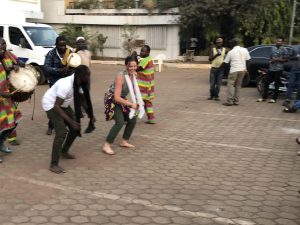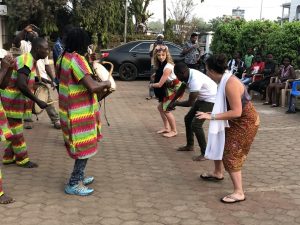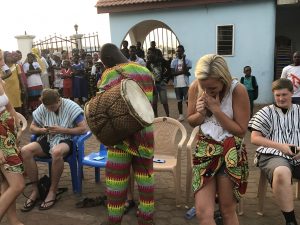Blogpost for Jan 23:
After our usual breakfast our day began with a lecture/discussion led by Prof. Abdulai that focused on a paper titled “The Impact of the Atlantic Slave Trade and Western Sudan” by Martin Klein. It sought to reinterpret Philips Curtin’s analysis of the demographics of Slavery in Africa, which evoked several responses from African scholars such as Baboucar. Philips Curtin ignored the emotions any discussion of Slavery evokes in people particularly impacted by it. But Martin Klein, who comes to his support, argues in this paper that Curtin be forgiven, for he only pointed to where the data led him.
The paper discusses the differences between the economic model and the political model of slavery. In the political model, slavery is considered to be an outcome of territorial expansion, and any prisons of war or slaves acquired are only a byproduct of expansion. In the economic model, slavery is viewed as a profit-driven business model above all else. One of the key components of the paper/lecture/discussion was the price fluctuations that can be observed in the literature pertaining to slave markets. These fluctuations are indicative of non-economic events such as famine, drought, or some form of political instability (ex. war). When one views slavery in the context of such events the political model becomes more relevant. In many ways these models overlap as political issues are often inherently economic, and vice versa.
We also engaged with the topic of societies’ level of dependence on slavery before, during, and after the trans-atlantic slave trade. The pervasive nature of the slave trade led to the deterioration and reshaping of the economic and political structures that acted as foundational elements of many societies. During the slave trade one can observe that the modes of production and levels of exploitation in these societies were completely transformed, leaving societies exposed to increased levels of economic and political instability.
We also noted that as time progressed, slave traders began to assign increased value to male slaves. Traditionally, female slaves had been viewed as preferable as they maintained adequate work capacity in addition to a capacity to complete domestic tasks not done by male slaves. This changed as the trans-atlantic trade progressed for a few reasons. First and foremost, strong men were better suited for surviving the harsh conditions slaves had to endure while moving from inland areas towards the coast. Second, the purchasing parties (ex. the Americas) placed increased emphasis on sheer labor force and productive capacity, thus negating any value assigned to domestic tasks. At the peak of the trans-atlantic trade 60-70% of the slaves exported were male.
Evening Entertainment
After we had wrapped up our lecture and discussion we ended the day with another visit from the youth center dancers. The first dance that they performed was called the Paki.

This dance was about a young man who was eager to prove his own self worth. In order to do so he had to obtain certain attire (ex. a smock), as this would signal to his community that he had become an independent man. This dance would traditionally be performed at a market after a long day of work. This dance acted as a venue for socializing and created an avenue for potential relationships to develop. The performers mentioned that some young men and women had even met their future spouses by participating in this dance! This dance was preformed by almost all men who were all wearing baggy pants and smocks. Each dancer also wielded a metal, wand-like object.

The second dance was described as being reminiscent of an old story about a king, his queen, and a friend-turned-monster. In this story, a king once married a beautiful woman. The king also had a friend named Jokiro, who became a menace and a monster to the king and his wife. The king consulted his friend (the monster) and he initially pampered him. Eventually though the friend began to demand all sorts of items from the king, creating many problems. The friend/monster then demanded that the wife must go outside of wedlock and get pregnant. The monster then impregnated the wife, infuriating the king. The king then sent warriors to kill the monster and therefore freed the wife. This dance, as the story goes, is typically performed by females who wish to celebrate their freedom. We were all very entertained as the dance involved each dancer repeatedly colliding with each other’s buttocks in mid air while moving in a circle.

The final dance we observed consisted of many individual dances. The performers explained how each family, village, or group would have their own unique dance moves. The dance was intended to be an expression of individuality, as each dancer would do their own unique dance to the beat of the drums.

After each member of the group had performed their dance the group asked members of our class to learn some traditional moves. We had a great time dancing with them and got some great photos!


We are looking forward to tomorrow!
